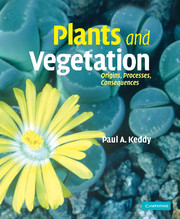Book contents
- Frontmatter
- Contents
- Preface
- Acknowledgements
- Chapter 1 Plants and the origin of the biosphere
- Chapter 2 Description of vegetation: the search for global patterns
- Chapter 3 Resources
- Chapter 4 Stress
- Chapter 5 Competition
- Chapter 6 Disturbance
- Chapter 7 Herbivory
- Chapter 8 Positive interactions: mutualism, commensalism, and symbiosis
- Chapter 9 Time
- Chapter 10 Gradients and plant communities: description at local scales
- Chapter 11 Diversity
- Chapter 12 Conservation and management
- Questions for Review
- References
- Index
- References
Chapter 9 - Time
- Frontmatter
- Contents
- Preface
- Acknowledgements
- Chapter 1 Plants and the origin of the biosphere
- Chapter 2 Description of vegetation: the search for global patterns
- Chapter 3 Resources
- Chapter 4 Stress
- Chapter 5 Competition
- Chapter 6 Disturbance
- Chapter 7 Herbivory
- Chapter 8 Positive interactions: mutualism, commensalism, and symbiosis
- Chapter 9 Time
- Chapter 10 Gradients and plant communities: description at local scales
- Chapter 11 Diversity
- Chapter 12 Conservation and management
- Questions for Review
- References
- Index
- References
Summary
Scales of investigation. Methods. The origin of angiosperms. Pangea. Gondwana. Laurasia. Glossopteris. Araucaria. Nothofagus. Ginkgo. Proteaceae. Quaternary events. Glaciation. Loess. Pluvial lakes. Drought. Sea level decrease. Migration. Hominids. Flooding. Succession. Definitions. Deglaciated valleys. Peat bogs. Sand dunes. Forests. Predictive models. Historical views on succession.
Introduction
We assume that our universe has three spatial dimensions and one temporal dimension. While these assumptions appear invalid at very small (subatomic) or very large (galactic) scales, they are an adequate means for describing the macroscopic world that we share with other living organisms (Ferris 1988). Although the measurement of space has been readily done, the quantification of time has posed more of a problem. Accurate measurement of time was a constant challenge to early navigators until John Harrison invented his chronometer. When Captain Cook returned from his second voyage in July 1775, he reported that Harrison's timepiece “exceeded the expectations of its most zealous advocate and by being now and then corrected by lunar observations has been our faithful guide through all vicissitudes of climates” (Sobel 1995, p. 150). Its reliability permitted Cook to accurately estimate his longitude for making maps of the South Sea Islands. Cook insisted on taking it with him again on his third and fatal expedition.
- Type
- Chapter
- Information
- Plants and VegetationOrigins, Processes, Consequences, pp. 403 - 456Publisher: Cambridge University PressPrint publication year: 2007



